A traffic diverter is a barrier placed in an intersection to prevent auto traffic from going through it. The goal is to make certain streets less attractive to auto drivers and reduce auto traffic volumes overall. So, when it’s relatively easy to drive through one — which is the case with a new diverter in northeast Portland — it sort of defeats the purpose.
The Bureau of Transportation recently installed a diagonal diverter on NE Rodney at Ivy. As we reported a few weeks ago, it was installed at the urging of the Eliot Neighborhood Association. With changes afoot on N Williams Ave, residents were concerned that Rodney would become a busy speedway full of impatient drivers cutting-through their neighborhood in search of a quick route north.
They were right. Since the lane changes on Williams (they’re still not fully complete), Rodney has seen a significant increase in auto traffic during the evening rush. And that’s where the diverter comes in.
Here’s what it looks like…
As you can see, the new diverter on Rodney consists of three separate median islands that stretch from the southeast to the northwest corner of the intersection. They’re only a few inches high and about a foot deep. On top of the concrete curbs are four foot high plastic bollards — a.k.a. “candlestick wands” — that are bright white with reflective tape at the top. In order for bicycle riders to be able to easily pass through, there are two openings in the median curbs which are about six to eight feet wide.
Unfortunately it turns out that that’s just wide enough for cars.
Last night I sat at NE Rodney and Ivy for about 30 minutes with my camera at the ready. It only took about 30 seconds to realize that the rumors I heard last week were true.
In the video below, you can see how easy it is for people to drive through. This person barely even slows down!
And here are several others caught in the act…
Advertisement
It’s also worth noting that every person who drove over it was coming from south (on Rodney) to north.
While this shockingly lawless behavior is certainly nothing I would personally partake in, let’s give these folks the benefit of the doubt: The physical footprint of the diverter is relatively minimal and there’s no signage explicitly advising drivers that it’s illegal to drive through it. And heck, their cars fit, so why not try it?
The lightweight design of this diverter might have something to do with the fact that PBOT says it was installed only as an experiment and that it can be removed if the traffic data and/or public feedback warrants it.
Last night, volunteers from Bike Loud PDX led a ride on Rodney to encourage calmer traffic and show support for the diverter. One topic of conversation was how this diverter could be designed to work better. The trick is, the openings have to be wide enough for a large cargo bike, a handcycle, a trike, or a bike pulling a trailer to fit — yet narrow enough so cars aren’t tempted to squeeze through.
(The problem with this diverter reminds me of other situations around town where PBOT seems afraid to install infrastructure that appears too anti-car; like those “fire-friendly” speed humps that have slots where car tires can easily fit through. These devices don’t achieve desired outcomes and only end up annoying all road users.)
I think the answer on Rodney is to provide a second row of barriers with off-set openings that a bike rider could easily navigate but a driver could not. My favorite diverter in the entire city is the one PBOT installed on N Central and Tyler (in photo below). Perhaps — if it becomes permanent — the city will consider doing something similar on Rodney…
In the meantime, please tell your friends and neighbors that driving through a diverter is illegal, dangerous, and uncivilized.

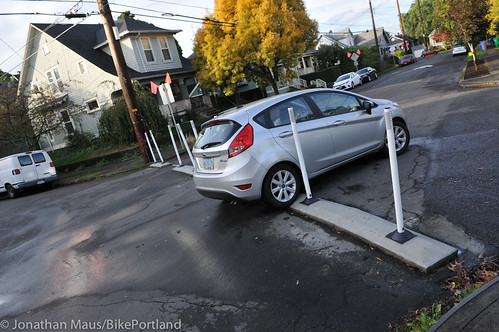
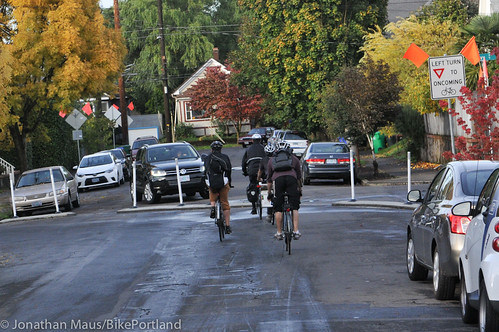
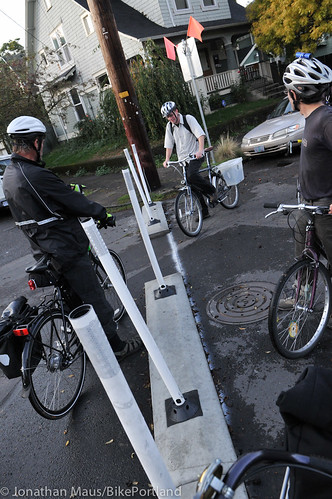




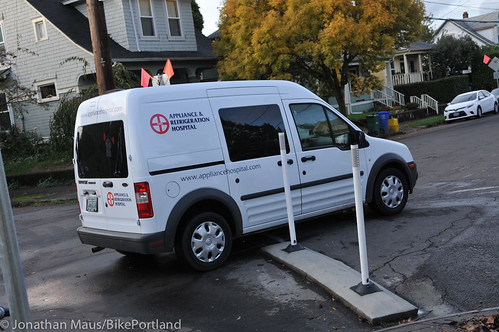
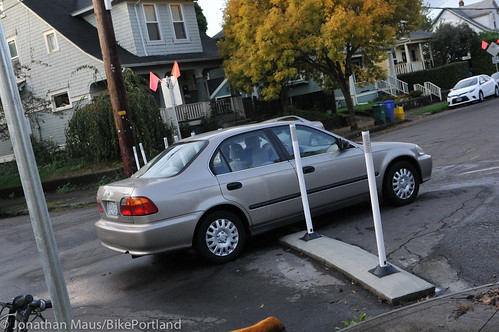

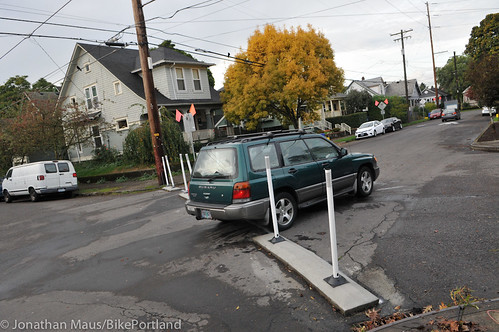
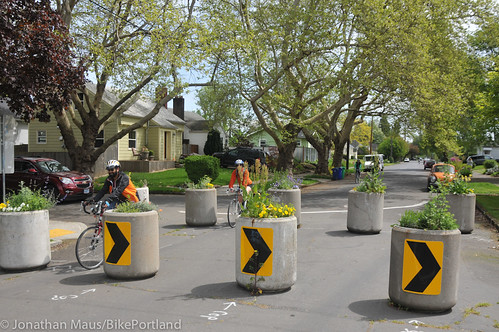

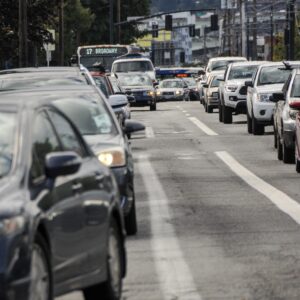
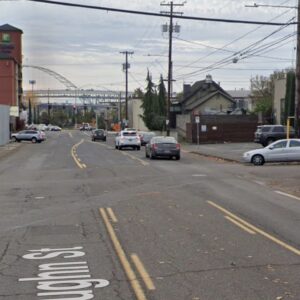
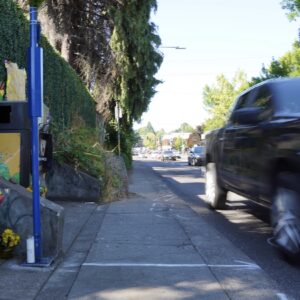
Thanks for reading.
BikePortland has served this community with independent community journalism since 2005. We rely on subscriptions from readers like you to survive. Your financial support is vital in keeping this valuable resource alive and well.
Please subscribe today to strengthen and expand our work.
I dont see how adding emissions by making people detour to a long route is a good thing.
Grids are good for a reason. Destroying the grid is not.
If speeding is an issue, add a speed bump.
Actually, a lot of Portland’s east side was intentionally developed with jogs to the grid causing discontinuity. Grids are just one form of urban design that can be modified. They aren’t sacred.
The “jog” wasnt actually an intentional development in the majority of portland but more or less two sides developing without precise alignment and the jog occured where these streets came together. This is opposed to other larger cities where the entire grid was laid out initially before any development. Like a very scaled down version of cities connecting where the city center determined the street layout not the surrounding/further elements.
Right, Portland was essentially a suburban land grab by developers. Thats why OHSU was built on top of a hill, the guy who sold land to the hospital didn’t bother telling them it was a cliff. Kind of like selling Florida swamp land to New Yorkers as vacation property.
Actually, that’s an urban legend.
Yes, as Chris said.
OHSU’s site was actually owned by an Eastern railroad company who clearly didn’t perform due diligence on the purchase. When they eventually figured out that the land would be useless for railroading, they (or some other intermediary) donated the land to form the medical school. (at least this is the story they tell us when we first get to OHSU)
Your comment likely reflects the Post 1940s curvilinear streets (aka Neighborhood Unit) or post 1960s cul-de-sacs were laid out to push regional trips to exterior arterials. A lot of this grid offset (pre 1940s) occurred between different land owners platting streets without coordination or in spite of it in different eras pre1940s
Keep in mind that people are choosing to drive and take this route.. No one is “making people” do anything. And building good streets for bicycling will ultimately reduce emissions as more people use them.
The grid is maintained quite nicely… if you are on a bicycle or on foot.
Designating a handful of streets here and there as safe routes for bicycles does not amount to “destroying the grid.” The amount of added emissions as a result is negligible.
Easier to bike/walk –> less driving –> less emissions. You have to look past today & see the future.
Just so. Even one more person deciding to bike rather than take their car offsets many additional blocks of diverting other vehicles.
You know what cuts emissions? Driving less.
You are right. A grid network of local streets is a good thing. Therefore we should probably begin right away on removing I-5, I-84, and I-405 throughout Portland and rebuild the neighborhoods that were once there. That would also come with the added benefit of lower emissions, win-win!
Most modern cars emit far fewer emissions than older ones, and most emissions are created in as the engine and catalytic converter warm up. Going a few blocks out of the way is not going to significantly add to the emissions generated.
I live 2 blocks from this diverter.
In my opinion, driving through the diverter is a nonissue.
I think the Rodney/Ivy diverter is doing its job extremely well.
The big, really big issue, that doesn’t seem to be getting much airtime on BikePortland or elsewhere is that PBOT is doing some excellent work on N Williams. Really really good work, that can set a precedent for huge improvements for bicycling elsewhere in the city.
The Rodney diverter was a latecomer to the game. Put in to me mountable by emergency vehicles, possibly designed to be passable by minivans and sedans.
The diverter is doing its job. 95% or 99% of cars don’t drive through it. Those that do go very slowly. It’s not dangerous to go through it slowly. And driving through this diverter doesn’t make them particularly more likely to disobey traffic control devices elsewhere.
The diverter was put in without much notice, it’s not on anyone’s GPS, the neighbors didn’t have 6 months notice to be able to explain to their friends the rather convoluted detours now required to get to their houses.
Letting folks drive through it allows a few tense motorists to not get any more frustrated than they already are. Not get any more late than they already are. And to find another route next time.
The diverter is doing its job very well.
Folks can complain about it, but I really really suggest we all channel our energies into praising the Williams Ave redesign. Because I suspect there will be a lot of pushback from drivers, and if we don’t match that with support, we may not see bikeway improvements like this again.
Cheers,
Ted Buehler
posting from Rodney & Beech.
Hi Ted,
I agree that in the grand scheme, this diverter thing isn’t a huge deal. Please don’t confuse this story’s placement on the front page as an indication of its seriousness/importance relative to other issues (remember, I don’t have margins to place stories).
To me, this post is more about a design issue and a way to let folks know that many more people are driving through this diverter than most people realize.
I think it’s a bad precedent if people are able to drive through what is supposed to be a full diverter. It will lower their compliance on all other devices and it erodes confidence in PBOT in general.
If this diverter is made permanent, I hope it gets beefed up and this issue gets fixed.
=======
(NOTE: There’s an unfortunate tendency by some readers of BikePortland to assume that every single post we publish is done to elicit a particular, advocacy-related response — such as complaints. Like this one, or the “confusion” post yesterday… when in reality those posts are simply documenting a moment-in-time and are done mostly to share information.)
A point that wasn’t included in the story, is that PBOT “fast-tracked” this diverter at the request of the neighborhoods and the BTA. And it’s a temporary trial.
So its not on anyone’s GPS, its not on emergency response maps, its not on Google Maps.
We can’t ask for thee diverter to be upgraded until it gets updated to the databases.
And since it was put in without the usual long, drawn out public review process (because that would have taken eons and possibly been turned down), its only temporary.
These are all key elements to the Rodney/Ivy diverter story, and they’re part of the reason that folks in cars can and do drive though it.
If we get it some decent civilized support, and engage in reasonable conversation with the immediate neighbors who are affected by it, then we can get it made permanent so that nobody can drive through it.
On the other hand, if its highly controversial, PBOT may conclude that the experiment was a failure and take it away. And folks on bicycles will need to deal with lots more cars when riding on Rodney. And it will be much harder to get other “fast tracked” traffic calming infrastructure installed in the future.
Ted Buehler
You must admit that the majority of your posts seem to incite the car vs bike argument. Is there a way to convey your pro bike message without portraying cars as evil?
It is unfortunate that that does seem to be the case. I think it pertains to one of a couple different reasons:
1) Drivers of cars literally are the cause of problems for cyclists: speeding through neighborhoods, passing too closely, aggressive tailgating, honking, injuring, killing, etc.
2) The bicycle and pedestrian infrastructure treatments that are often reported on here (and touted as “world class”), when compared to what car drivers enjoy, are often quite inferior and looking at them highlights that we seemingly continue to always expect that bicyclists and pedestrians will kow-tow and defer to the obvious superiority of drivers in cars.
3) Many times, people like to compare the relative environmental impact of driving a car vs. riding a bike. If these two modes could operate without any interaction whatsoever, we could say that a bicycle was virtually infinitely less damaging to the environment, but when we create “infrastructure” that does nothing to encourage switching to a bicycle for some trips, and when we attempt to mix bicycle and auto traffic in ways that seem to create congestion—as some commenters on this article suggest—then it becomes more of a finger-pointing contest with drivers saying that bicyclists are causing them to sit in traffic longer, generating more exhaust, while cyclists complain that if drivers got out of their cars, all of their exhaust would go away, etc.
It is just a fact that our transportation environment has been overbuilt and optimized for auto use, and attempting to backpedal (ha!) and retro-fit things for more common-sense use of bicycles, feet, or transit necessarily has to undo some of that over-optimization for cars. That feels like a take-away to drivers, and long overdue fair treatment for bicyclists, so you can imagine what that leads to.
I also live 2 blocks from this diverter (hi Ted, I guess we’re neighbors), and I agree it’s mostly doing its job even though a few people drive through it. What we really need are MORE diverters along Rodney. If there was one every few blocks, drivers would quickly realize that detouring from Williams to Rodney is pointless. As of now, drivers probably save time by coming up Williams from Russell to Ivy. Any permanent diverters should be designed better, but for now the mere existence of this one is having a big impact on traffic volume. We just need more of them.
Shawn — agreed. I’m still hopeful that after the construction is done on Williams that the car throughput will be high enough that not a lot of folks will use Rodney. If not, the issue will be considered at the Eliot Neighborhood Association, which has a fair number of members who were opposed to any sort of diverter at the Rodney meeting I attended this spring. Some have probably softened up their opposition after seeing the volume of cut through traffic this month, but some probably haven’t.
Also, if you haven’t already done so, I’d recommend sending a personal note to Rich Newlands, traffic engineer for the Williams/Rodney project, and tell him you live 2 blocks from the diverter and you support it. He is getting pushback from all sorts of folks, many of whom are immediate neighbors. So any possible support from immediate neighbors is helpful here.
Rich Newlands
Portland Bureau of Transportation
1120 SW 5th Ave
Portland OR 97204
Ted Buehler
Beech and Rodney
I wrote:
“Those that do go very slowly. It’s not dangerous to go through it slowly.”
I didn’t see the “this person barely slows down” text or click on the video earlier. I see my claim is incorrect, and that some people drive through it fast.
I think that if fast-driving through the diverter does become more common, then I think we all should request to PBOT do something to counter the behavior, like install additional candlestick bollards to narrow the gap and not let sedans drive through without mowing down a bollard, and replace them as necessary.
And, even if they don’t want to do it today, they should definitely do it in a couple weeks then the construction on Williams starts to wrap up and car throughput us up a little higher, when Ivy neighbors have had time to figure out which alternate route is best to get their car home, and when car drivers get used to taking MLK or Interstate.
My $0.02,
Ted Buehler
I question whether is is explicitly illegal for cars to go through this diverter since there is no regulatory instruction (i.e. white sign) like “Left/Right turn only except bicycles”. The bollards they placed are hardly imposing and I wonder if they fall under standard roadway facilities. Is it any wonder anyone is doing a cut through?
All that is to say, it’s obvious what the diverter’s function is – but would a ticket stand up in court?
I think the bigger issue is that not ONE of those vehicles should be driving on Rodney in the first place.
Not ONE.
If you were to look up the license plates of each vehicle, I bet you would find not a single one belongs to a motorist who lives on Rodney. Or even, a single motorist who lives in that neighborhood.
If that many vehicles were photographed going over the diverter in only 30 minutes, and we’re assuming they are just the “bad apples” that make up one or two percent of the drivers, how many OTHER vehicles are on Rodney now too?
I hope PBOT fixes this diverter and fast.
Adam — I saw a neighbor drive through it to park in front of her house. Just sayin.
Ted Buehler
I also live in the neighborhood and would never think because I do that it gives me some extra right to drive through the diverter. It seems pretty obvious without signs that cars shouldn’t go through it. Just sayin.
I think that’s a bit extreme. I’m a driver as well as a cyclist, and I don’t see neighborhood streets as off-limits to me if I’m driving from one part of town to another. Sometimes I’ll take side streets just to vary my routine. But I agree that Rodney should be protected from as much cut-through traffic as possible, because we already have Williams/Vancouver and MLK (not to mention a certain interstate highway) as major north/south routes.
I drive on neighborhood greenways because they’re calm and slow… I’d rather go 20 mph than be in bumper to bumper traffic with a bunch of dangerous scofflaws…
You are the reason we need more diverters on greenways.
I agree… I’ll find another slow quiet street to drive on… but then I’ll be driving too slow…
Its weird, since I bike so much, when I do drive, I find myself wanting to drive the same routes that I bike!
I don’t actually do that, 99% of the time, as driving down the springwater is rather illegal. But I find the navigation difference between cycling and driving can be… strange.
it doesn’t help that when I drive I’m also on 2 wheels…
I don’t think there’s a problem with driving on neighborhood streets. I live on a neighborhood street that is also a major shortcut between two collectors/arterials (and as such, also a major de facto, i.e., undesignated, bike route, which I love) that lots of people use who are “just passing through”. As long as driving on neighborhood streets is done respectfully, I don’t have any problem with it. The problem comes when drivers, as drivers do, demand supremacy on every street through bullying and intimidation. If drivers cared to understand and respect the fact that a street was designated as a neighborhood greenway and drive in a way that did not intimidate or threaten cyclists using that street, there wouldn’t be a problem. There could be a whole parade of cars and bikes, in single file, all going 12 mph, leaving comfortable distance with no tailgating, honking, or engine-revving, and all would be cool. The only problem comes when drivers, as most driver’s can’t, can’t tolerate the slower speeds and perceived “back-ups” on such streets and start driving aggressively, attempting to sweep cyclists off to the side and speed past them. As my mom might have said to us kids growing up, “looks like you’re too little to drive safely, so we’ll have to put up diverters.”
I guess the lawlessness offends my sense of justice a little but I have nothing against cars taking cut-throughs on side streets. As long as they behave themselves and move no faster than 15mph. If these “diverters” accomplish that, that’s a good result too I guess. So they’re traffic baffles, maybe? Is that a thing? “Traffles?”
And they have Oregon plates too! (No marauding Washingtonian drivers yet.)
The design and lack of signage make it look like the purpose is to slow cars down, not prevent them from entering.
But where would anyone ever have seen anything like this used to “slow cars down”?
you are right! Let’s get rid of I5 and reattach the grid in these neighborhoods.
It would have wonderful impact on our city.
Seriously though, the auto network is already overly congested, not to mention that it’s killing the humans and the planet. Hopefully a little diversion on our neighborhood greenways will help offer anoption to all those people who are about to move into all those buildings popping up.
What, they couldn’t put in diverters spaced like the deadly ones beneath the freeway between the intersection of SE Clay/SE Water and the East Bank Esplanade?
I can say this, If everyone drove cars that were this size or smaller we’d be in a lot better shape generally. And there’s not a Washington plate in the lot.
Having a design that allows easy transit by emergency vehicles remains one important consideration for a long term solution.
Many places in Europe use (heave) retractable bollards that emergency vehicles (and sometimes neighborhood residents) can use for passage.
Central and Tyler. What an exquisitely placed diverter that’s not too hard on the eyes. Clinton? Ankeny? Michigan? Actually, I would take a well-placed wine barrel… anything right now.
I really like the diverters on Central. I love the plants that pop from the top of them. What if we also took the boring concrete look away from them and encapsulated them in a wood theme or something, making them look less industrial? What if diverters were all pretty and added some panache to the street? Make them practical and beautiful!
The nice one on cental and the one on Rodney also cost about the same. Why not have the city buy a few dozen of these planters and add diagonal diversion at greenway intersection throughout the eastside?
If the neighbors do not like the placement after a few months, then they can be moved. Ankeny/16th, Clinton/28th, Going / 24th….
Twice in the last month I’ve watched cars drive over the diverters on SE 20th and Ankeny. Lot of very determined motorists out there.
I use the Central route several times a week. Every once in a while, I find the planters nudged out of the way, presumably by someone not quite functional behind the wheel. Anyone know the real story?
I emailed the Appliance Hospital to make them aware of their driver’s lawless behavior…
I’m big on notifying a business that has drivers breaking the law… I expect full compliance with the law if you’re getting paid to drive…
already got a response…
“Thank you [Spiffy], we will address. Not acceptable!”
thank you Jeremiah for taking this up with your driver… many road users will thank you…
You sir… are On It! well done, I was thinking the same thing!
no, let’s not give them the benefit of the doubt… there’s no other road feature like this anywhere that allows you to drive through it… these people know they’re breaking the law (just like most drivers)…
I’d drive through/over it.
Are they actually breaking an actual law though? There’s no regulatory signage and these diverters are hardly standard roadway facilities (and even less so imposing).
Don’t get me wrong though, I see it as unethical. I just wonder if anyone could actually get a ticket that would stick.
I live right next to this intersection and am glad to see this getting reported on. It’s annoying and dangerous, it’d be nice to have some enforcement if PBOT expects this to be followed.
But… But…. *%&*# stop sign running cyclists are irresponsible scofflaws, and a menace to society …..
Nothing to see here….
So can I get a diverter put on N. Montana Ave since folks use that street when Interstate Ave is backed up? Or is Rodney getting somekind of special treatment since folks simply feel uncomfortable with more traffic on their street???
I called appliance hospital as well. Sounds like they have been getting a great deal of feedback around this article.
oh good, I was hoping multiple people would bring it to their attention so that they took it seriously…
if you’re being paid to drive then you should drive like you’re being recorded at all times…
“While this shockingly lawless behavior is certainly nothing I would personally partake in, let’s give these folks the benefit of the doubt: The physical footprint of the diverter is relatively minimal and there’s no signage explicitly advising drivers that it’s illegal to drive through it. And heck, their cars fit, so why not try it?”
I think you’re a lot more benevolent than I Jonathan. I just can’t imagine driving up to that in a car and saying to myself “Yep, it’s totally fine for me to fit through here. Look, they even made it just wide enough for my car.”
I would guess that 80-95% of the people doing this know they are doing something wrong/illegal.
I’m curious about why that intersection was chosen for the diverter. Does anyone know, or have an educated guess? In any case, I agree with others that it’ll be difficult to realize the potential of the diverter strategy without another diverter or two further south on Rodney. I also agree with Ted B. that PBOT deserves kudos for its efforts on Williams/Rodney.
Jonathan F. —
The diverter was located at Rodney and Ivy for 2 reasons —
1) It keeps east-west traffic from I-405 to NE Fremont Ave from cutting through the neighborhood.
2) It keeps northbound traffic on Williams from using Rodney as a cut-through to Fremont. And Rodney is the only north-south neighborhood street connection from downtown Portland to N & upper NE Portland.
Two problematic cut-through routes, both blocked by a single diverter.
I used 2 maps to illustrate these points when I was tabling for postcards at the “Yes to the Rodney/Ivy Diverter” campaign. (the maps are also shown in this photo http://bikeportland.org/wp-content/uploads/2014/10/bikeloud-maps.jpg from the BikeLoudPDX Postcard post),
1) East-west diversion function.
https://www.flickr.com/photos/11599639@N03/15432847530/
Shows the I-405 ramps on the left, in red, and Fremont St. in red on the right. Solid orange routes are the streets developed for through traffic — Cook to Williams, Vancouver/Williams to Fremont, and Fremont from Vancouver to the east. Dotted orange lines are how this traffic was cutting through the neighborhood to avoid the clogged up through streets. The black “Diverter” line shows how the cut-through traffic is blocked.
2) North-south diversion function
https://www.flickr.com/photos/11599639@N03/15618447365/
Shows the east-west hills in N-NE Portland in red — red line on left is the Willamette Bluffs, red line on the right is the Alameda Ridge. Orange and green lines going north-south are the only direct routes from downtown to N Portland and upper NE Portland that don’t climb an annoyingly steep hill somewhere along the route. They are Vancouver, Williams, Rodney, MLK and 7th. Of these, Rodney is the only route that’s fabulous for the “8 to 80” crowd — slow riders, parents with kids, newbies, grandpas, etc. So, to keep downtown Portland accessible to the 8 to 80 crowd, its imperative to keep Rodney traffic calmed. And the diverter at Ivy keeps northbound traffic from Williams from using Rodney all the way to Fremont. (As we’ve seen, it doesn’t keep traffic from using Rodney up to Morris, then going east to MLK, or up to Ivy and jumping back onto Williams, likely ahead of where they would have been otherwise).
Make sense? Clarity missing anywhere? Comments, corrections, divergent opinions?
Ted Buehler
Thanks Ted, that does make sense. I hadn’t given much thought to the drivers exiting I-405, perhaps because when I take that exit, I would much rather turn left on Williams than cut across the bike and car traffic on Williams to proceed east on Cook. But I guess some drivers do cut across. I wonder how the signal will change this practice.
For the drivers heading north on Williams from, say, Broadway, it seems to me that Rodney is still a good option for them because they can get all the way up to Ivy before being diverted.
It wouldn’t take that much effort to tighten the aperture and discourage this driver behavior. A 5′ opening would do the trick.
Honestly, I think most of the drivers going through are just confused. Diagonal diverters (heck, diverters of any kind, sadly) are not a common feature in our city, much less temporary ones like this one. And the openings are aligned for where people would want to drive, and are almost wide enough. Needs better design and/or signage.
I was thinking the same thing, Alex. Signs making it clear that only bikes are supposed to drive through it.
Seriously, if people can’t figure out that their car doesn’t/shouldn’t fit through there then they shouldn’t be driving!!! It blows my mind! Yeah, maybe for some it’s a pain in the ass to have the diverter there, but that doesn’t mean people have to drive like one.
Question for Jonathan: do these new diverter intersections have advance warning signage telling drivers that they cannot go straight? (From the photos with this report the signage does not seem to prohibit the thru movement.) So it may be difficult for PPB to enforce.
If I lived nearby, I would probably fashion a few wooden planter boxes, paint them yellow, and narrow that gap down a bit.
As for the wide gap failing to divert thru traffic – any operations staffer could have told the planners that leaving a ~5 foot gap would allow most cars to squeak on thru. What is the measurement?
Thus why were the raised curbs not moved ~1.5 additional feet away from the corners? (This would lighten up the gap and keep the leaves from hanging up on it at the catch basins too.)
Or was there some unmentioned institutional reason to leave such a wide gap…was it fire or EMS requirement, etc?
It may not be “that” dangerous now but these people need to be made aware of their multiple driving infractions here… I can think of about 3 different infractions and 1 or 2 that would carry hefty fines.
And if you place a child riding through or near that diverter at the time of the infraction it can become a Huge fine. (or possibly much worse)
This is what makes it very dangerous and much more than just some people squeezing through a new/unannounced speed/traffic diverter.
There is zero tolerance for dangerous driving in a residential area, it goes double in this case.
So No I don’t think we give them the benefit of the doubt, I think we document and prosecute every last one of them!
Hello all;
I was at the bikeloud event yesterday and I definately saw a HUGE amount of cut-through traffic. It wasn’t just a few cars. There were at times a solid block of bumper 2 bumper cars. Biking up the street I felt very stressed by the obvious impatience of the drivers revving their engines to get around me and then being frustrated by oncoming traffic.
Ted
“In my opinion, driving through the diverter is a nonissue.
I think the Rodney/Ivy diverter is doing its job extremely well.”
I would both agree and disagree. Having been there and seeing the looks on peoples’ faces it was clear to me that when I and others were standing at the diverter, people were often very angry and were wanting to speed right through, but weren’t willing to do so with 5-6 people watching.
I do think that the diverter is MUCH better then nothing. That said….
“The Rodney diverter was a latecomer to the game…A point that wasn’t included in the story, is that PBOT “fast-tracked” this diverter…. Put in to me mountable by emergency vehicles…The diverter was put in without much notice, it’s not on anyone’s GPS….”
I fully agree that as a ‘quick and dirty’ installation to reduce throughput on Rodney it is a worthwhile experiment. I wholeheartedly agree that it would have been highly impractical for PBOT to go through the usual yearlong fandangle. In situations like this (and as an exception to the rule) I think that the democratic process is more hindrance. Cars and bikes/peds democratically sharing the same road is not equal access for all.
Jonathan M
“I think it’s a bad precedent if people are able to drive through what is supposed to be a full diverter. It will lower their compliance on all other devices and it erodes confidence in PBOT in general.
If this diverter is made permanent, I hope it gets beefed up and this issue gets fixed.”
I wholely agree with Jonathan on this point. Despite what many people say when bike/car compliance is brought up, drivers follow the law rarely and only when the social stigma or threat of a ticket forces them.
Shawn
“What we really need are MORE diverters along Rodney.”
Excellent point. If we had one diverter just north of Russell, and one north of Tillamook, there would be very little throughput. This has been done all over northern Europe (not just Denmark) where arterials take the through traffic and neighborhoods have diverters to prevent cut-through traffic…all neighborhoods.
Ted
“I’m still hopeful that after the construction is done on Williams that the car throughput will be high enough that not a lot of folks will use Rodney.”
I wish that I could be as optimistic. However the issues on Clinton St and with what I’ve seen on other bike blvds, I have much less faith.
“If not, the issue will be considered at the Eliot Neighborhood Association, which has a fair number of members who were opposed to any sort of diverter at the Rodney meeting I attended this spring. Some have probably softened up their opposition after seeing the volume of cut through traffic this month, but some probably haven’t.”
I definitely hope that residents soften their opposition and see what the huge amount of cut-through can do to the livelihood of a neighborhood.
“Also, if you haven’t already done so, I’d recommend sending a personal note to Rich Newlands, traffic engineer for the Williams/Rodney project.”
Rich Newlands
rich.newlands@portlandoregon.gov
I’ve sent in my support.
Jonathan F
“I’m a driver as well as a cyclist, and I don’t see neighborhood streets as off-limits to me if I’m driving from one part of town to another.”
This is the type of behavior which makes residents very upset, makes parents unwilling to let their kids play outside, and makes people less comfortable walking or biking for local trips resulting in more people driving. It frustrates me very very much. Not only the people who drive slowly (who still consume 800 sq ft of road space). But all the more so, the many people cut through neighborhoods at 25-30mph and even if they’re slow, they often pass me (frustrated) at higher speed.
“I agree that Rodney should be protected from as much cut-through traffic as possible, because we already have Williams/Vancouver and MLK (not to mention a certain interstate highway) as major north/south routes.”
Yes, there are lots of other options.
hey look a short cut.. doh!
Here is a solution from the past:
http://s134542708.websitehome.co.uk/pillboxes/assets/images/db_images/db_hedgehog3.jpg
“…Rodney has seen a significant increase in auto traffic during the evening rush.”
Personal observations? Any idea of their orgin – like I-405 off ramp from Cook? Seems to me this is not a new issue at this location. PBOT has frequently heard about issues of traffic going around the signal at Fremont and Williams during congested times. People coming off the ramp also go south on Vancouver just to get a block or two south so they can head east or north again. Once the city adds a signal at Cook/Williams and again at Cook/Vancouver the flushing of traffic through the neighborhood can almost begin. the only control left to meter traffic into the neighborhood will be the stop sign at the off-ramp.
The origins of the traffic have been discussed a great deal here already: the current construction project that’s reconfiguring all of N. Williams.
Also, the stoplight at Williams & Cook is already in.
In the name of science, I’m going to go out and observe the diverter from 5:15 to 5:45 today to collect data.
I realize I may, to one degree or another, end up to eat my rosy words written earlier.
I’ll be counting:
* Cars, in each direction
* Bikes, in each direction
* Cars driving through the diverter
* Relative speed of cars driving through the diverter
* State of registration of cars driving through the diverter.
Any other requests?
Any traffic enforcement officers that may or may not appear?
Note. Traffic was not gridlocked on Williams today. A rider I talked to said it was only backed up from Fremont to Morris. While yesterday it was backed up all the way to Broadway.
I hid behind a fence the whole time, so northbound drivers couldn’t see me. Another bicyclist joined me for about 8 minutes to chat, he was visible, but wasn’t looking “hawkish”
Data is as follows:
5:10 – 5:40
Cut through cars: 6
Registration of cut through cars: OR 5, WA 1
Instances of cut throughs: 3
(One group of 3, one group of 2, one solo. I suspect the followers were just doing the “follow the leader” thing and probably wouldn’t have cut through on their own).
Fast cut-through cars: 0
Bicyclists: 10
Northbound: 4
Eastbound: 3
Southbound: 1
North=>West: 1
Cars total: 112
North => West: 69
East => South: 11
West => North: 17
South => East: 7
South => North: 2 (U-turn)
North => North 6 (through the barrier)
Pic of data and intersection here:
https://www.flickr.com/photos/11599639@N03/14998822414/
My conclusion:
On an average traffic day on Williams, cut through traffic on the Rodney/Ivy diverter is moderate. 6 cars in 30 minutes. None going fast, only 1 with WA plates. This isn’t a big safety issue, nor is a big noncompliance issue. All it would take would be a couple more plastic wiggly things, vertical or horizontal, to block most of these cars most of the time.
Also, there are no traffic control devices at the intersection itself to indicate that cars can’t drive over the barrier. Nothing from the MUTCD or the Oregon Driver Manual provides instruction, at the diverter, that cars can’t go straight. If PBOT can install a couple yellow arrow signs indicating that cars need to turn, it would help compliance. They can be plastic and floppy, but need to be in the middle of the roadway as the MUTCD dictates. Figure 2C-2, Figure 2C-13 Pretty basic stuff. So we can all be pissy and give car drivers the evil eye, but until PBOT actually installs signs on-site directing cars to turn, its of questionable value.
I still think the diverter is working very well. If if worked better and stopped all cars, there would be more pushback from frustrated neighbors. If it let more cars through, it would need to be beefed up. As it is, PBOT hit the sweet spot, diverting most cars, but leaving it possible and legal to drive through it if folks really want to. I’m optimistic that PBOT, when the time is right, will beef up the diverter so folks in cars can’t go through it.
Ted Buehler
So there were 10 cut thru bikers too.
Good data, Ted–thanks. It’s a little depressing to see that 112 cars came through in only a half hour, and on a relatively light traffic day no less. I’d be interested in helping with another study–I was thinking we could position a few people on Rodney so they can see down the side streets to Williams and note where drivers are coming from. I.e., how many cars are coming all the way south from below Russell? How many are turning off Williams onto Stanton, or onto Monroe, etc.
Sure, let’s do it. Tue – Thurs are considered to be the days to collect valid data. What day works best for you. I can probably find 1 or 2 other volunteers in my immediate neighborhood. Anyone else want to join in?
It will be interesting to see if we find any patterns. I’m thinking there will be a steady attrition of cars off Williams, and some will cut east to MLK at Morris, and some will jump back in to Williams at Ivy, possibly ahead of where they would have been otherwise.
The 112 cars isn’t all that bad in terms of what’s considered suitable for a neighborhood greenway. That translates to 224/hr. And average daily traffic is considered, I think, to be 5x the peak hour. Or, 4x for streets that have only one peak hour (Rodney doesn’t have a morning peak hour, as far as I know). 4 x 224 is only 896, well under the 3000 maximum motor vehicle counter per day for a shared roadway.
It still sucks, though, because up until a year ago Rodney was a reaaaaaly quiet street. Super chill. Cross traffic at Russell and Fremont, but other than that you could ride it without a care in the world from Broadway to Going/Alberta. I doubt its ever going to be that chill again, unless we get a whole lot fewer cars on the road, which is specifically counter to the plans or goals of PBOT, Metro, ODOT, Oregon, or a whole bunch of other entities. But, hey, maybe a miracle will happen…
Ted Buehler
“Also, there are no traffic control devices at the intersection itself to indicate that cars can’t drive over the barrier.”
or that bikes can’t proceed through it…
it’s a traffic diverter… nothing on it says that bikes are allowed through…
Count the WA plates too. And order a pizza 😉
Done…thanks.
A few more details and links:
Traffic enforcement officers present: 0
Links to the “turn” signs and “object markers” required to make the diverter a something that legally prohibits cars from crossing, rather than just makes it difficult.
Figure 2C-2 http://mutcd.fhwa.dot.gov/htm/2009/part2/fig2c_02_longdesc.htm
Figure 2C-13 http://mutcd.fhwa.dot.gov/htm/2009/part2/fig2c_13_longdesc.htm
Link to Oregon Driver Manual, “Warning Sign” section.
p. 18, the “Sharp Right Turn” sign is installed, but somewhat obstructed by vegetation.
p. 19, the “Chevron” road turns arrow sign is what probably needs to be installed on the diverter itself to make it illegal to drive a car through.
http://www.odot.state.or.us/forms/dmv/37.pdf
Photo of Rodney looking south, showing how the “left turn ahead” sign is obstructed by vegetation, and there are no arrows or obstacle markers on the diverter at the turn itself.
https://www.flickr.com/photos/11599639@N03/15433457768/in/photostream/
FWIW,
Ted Buehler
you forgot the “do not enter” and “except bicycles” signs…
Also, an Appliance Repair Hospital van went was going north and turned west around 5:30. This behavior change may be a result of everyone who contacted APR today. Its evidence that sharing your concerns about safety can bring results.
I’d encourage everyone with an opinion on this diverter to also contact PBOT’s traffic engineer Rich Newlands. He has said he’s getting plenty of phone calls from people who want to see the diverter removed. If it’s important to you as a person who rides a bicycle to see Rodney preserved as the only quiet neighborhood street connecting N and Upper NE Portland to downtown, I hope you all are supporting the Williams Project as enthusiastically as you’re picking up the phone and dialing up the Appliance Hospital.
Give the diverter some love by contacting Rich. (Or any other city staff or public official, but Rich is the official contact point for the project).
Rich Newlands
rich.newlands@portlandoregon.gov
503-823-7780
Portland Bureau of Transportation
1120 SW 5th Ave
Portland, OR 97204
Just sent Rich this –
“Hey Rich,
I just wanted to provide a kudos for the diverter put in on Rodney. Albeit it has problems and I’d like to see those fixed (re: http://bikeportland.org/2014/10/24/people-driving-right-new-diverter-ne-rodney-112660) – I want to make sure you’re getting some positive response contrary to those negative “tear it out” comments.
I ride that route regularly, 2 to 12 times a week depending on business and I often divert off of Williams and now travel on Rodney. Especially during rush hour when the air is stifling with motor exhaust from the vehicles traveling up Williams.
Thanks for the excellent, and I know hard work everybody puts in over there.
Actually it’s the result of knowing it was there
Good job Spiffy,
Though I essentially got the single finger salute from the auto glass company that operates from down my street when complaining about their fast driving and lack of stopping at the stop sign, luckily there are other glass shops to patronize . If everybody would bother to take note the commercial drivers that ignore/abuse the driving laws it could help a lot.
Emails are fast and easy. I’m also amazed at the number of drivers that ignore the 20 MPH speed limit in school zones. As long as drivers are anonymous/autonomous this will continue.
Before you take your “business” elsewhere, you may just want to walk into the shop (professionally dressed as a neighbour) and ask to speak to the owner/ manager about what you (and others) are seeing on your collective street. And from this interaction see if you should take your business elsewhere. (Assuming you have not already tried this.)
Well, one of those vehicles was an ambulance. 😉
Not going to an emergency or otherwise necessitating breaking the law, nor are flashing lights particularly a reason to circumvent traffic management systems either, except in some situations. There’s a reason ambulances still stop at red lights, at least for a moment.
You missed the joke. The ambulance was from the appliance hospital (see picture above).
I’ve said it before here http://transitsleuth.com/2013/11/02/multnomah-street-illegal-parking-and-street-vandelism-who-to-call/
…the photo at the end of the entry is perfect. They could even be removable bollards or planters if it is a temporary diverter… but the plaster bollards and minor 2-3 inch speed bump does NOT make an effective diverter.
…even though that’s obvious from the pictures/video etc.
I miss those signs that said “Severe Tire Damage will Result” and those really nasty looking metal claws that went with them.
I don’t know if it’s most drivers or just a few bad apples — and it doesn’t matter. Without frequent diverters our Greenways will never be inviting for children to ride on.
Sadly, the best method to get a car to slow down is to drive another car slowly in front of it.
Behind which, a driver who wishes they could go faster will mutter under their breath, maybe pound their steering wheel, and perhaps honk a bit, but will never consider aggressively passing or running Granny off the road…or yelling at her to “drive on the sidewalk”.
Maybe it’s not Granny, but just a conscientious driver who cares for the lives of their neighbors.
Pretty hard to escape the conditioning we’ve been subjected to all our lives, that slow traffic just DOESN’T BELONG on the roads…..
1) A big “do not enter” sign probably would get the point across. A cop sitting there would get the point across even more.
2) Speaking of cops–is the diverter designed so that emergency vehicles might pass through?